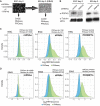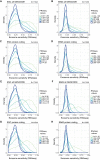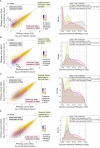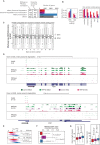The RNA exosome contributes to gene expression regulation during stem cell differentiation
- PMID: 30212902
- PMCID: PMC6265456
- DOI: 10.1093/nar/gky817
The RNA exosome contributes to gene expression regulation during stem cell differentiation
Abstract
Gene expression programs change during cellular transitions. It is well established that a network of transcription factors and chromatin modifiers regulate RNA levels during embryonic stem cell (ESC) differentiation, but the full impact of post-transcriptional processes remains elusive. While cytoplasmic RNA turnover mechanisms have been implicated in differentiation, the contribution of nuclear RNA decay has not been investigated. Here, we differentiate mouse ESCs, depleted for the ribonucleolytic RNA exosome, into embryoid bodies to determine to which degree RNA abundance in the two states can be attributed to changes in transcription versus RNA decay by the exosome. As a general observation, we find that exosome depletion mainly leads to the stabilization of RNAs from lowly transcribed loci, including several protein-coding genes. Depletion of the nuclear exosome cofactor RBM7 leads to similar effects. In particular, transcripts that are differentially expressed between states tend to be more exosome sensitive in the state where expression is low. We conclude that the RNA exosome contributes to down-regulation of transcripts with disparate expression, often in conjunction with transcriptional down-regulation.
Figures





Similar articles
-
A Functional Link between Nuclear RNA Decay and Transcriptional Control Mediated by the Polycomb Repressive Complex 2.Cell Rep. 2019 Nov 12;29(7):1800-1811.e6. doi: 10.1016/j.celrep.2019.10.011. Cell Rep. 2019. PMID: 31722198 Free PMC article.
-
Rbm24 Regulates Alternative Splicing Switch in Embryonic Stem Cell Cardiac Lineage Differentiation.Stem Cells. 2016 Jul;34(7):1776-89. doi: 10.1002/stem.2366. Epub 2016 Mar 28. Stem Cells. 2016. PMID: 26990106
-
The RNA exosome shapes the expression of key protein-coding genes.Nucleic Acids Res. 2020 Sep 4;48(15):8509-8528. doi: 10.1093/nar/gkaa594. Nucleic Acids Res. 2020. PMID: 32710631 Free PMC article.
-
SKI complex: A multifaceted cytoplasmic RNA exosome cofactor in mRNA metabolism with links to disease, developmental processes, and antiviral responses.Wiley Interdiscip Rev RNA. 2023 Nov-Dec;14(6):e1795. doi: 10.1002/wrna.1795. Epub 2023 Jun 29. Wiley Interdiscip Rev RNA. 2023. PMID: 37384835 Review.
-
Post-transcriptional control of cellular differentiation by the RNA exosome complex.Nucleic Acids Res. 2020 Dec 2;48(21):11913-11928. doi: 10.1093/nar/gkaa883. Nucleic Acids Res. 2020. PMID: 33119769 Free PMC article. Review.
Cited by
-
Exosomes in pathogenesis, diagnosis, and treatment of pulmonary fibrosis.Front Pharmacol. 2022 Aug 25;13:927653. doi: 10.3389/fphar.2022.927653. eCollection 2022. Front Pharmacol. 2022. PMID: 36091791 Free PMC article. Review.
-
Exosomal circLPAR1 Promoted Osteogenic Differentiation of Homotypic Dental Pulp Stem Cells by Competitively Binding to hsa-miR-31.Biomed Res Int. 2020 Sep 28;2020:6319395. doi: 10.1155/2020/6319395. eCollection 2020. Biomed Res Int. 2020. PMID: 33062690 Free PMC article.
-
Escaping nuclear decay: the significance of mRNA export for gene expression.Curr Genet. 2019 Apr;65(2):473-476. doi: 10.1007/s00294-018-0913-x. Epub 2018 Dec 4. Curr Genet. 2019. PMID: 30515529 Review.
-
Specific trophoblast transcripts transferred by extracellular vesicles affect gene expression in endometrial epithelial cells and may have a role in embryo-maternal crosstalk.Cell Commun Signal. 2019 Nov 14;17(1):146. doi: 10.1186/s12964-019-0448-x. Cell Commun Signal. 2019. PMID: 31727082 Free PMC article.
-
Ultraefficient extracellular vesicle-guided direct reprogramming of fibroblasts into functional cardiomyocytes.Sci Adv. 2022 Feb 25;8(8):eabj6621. doi: 10.1126/sciadv.abj6621. Epub 2022 Feb 25. Sci Adv. 2022. PMID: 35213232 Free PMC article.
References
Publication types
MeSH terms
Substances
Grants and funding
LinkOut - more resources
Full Text Sources
Other Literature Sources
Molecular Biology Databases
Research Materials
Miscellaneous

